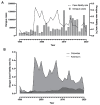Dengue Infections in Colombia: Epidemiological Trends of a Hyperendemic Country
- PMID: 33022908
- PMCID: PMC7709707
- DOI: 10.3390/tropicalmed5040156
Dengue Infections in Colombia: Epidemiological Trends of a Hyperendemic Country
Abstract
Dengue is a major public health problem in hyperendemic countries like Colombia, the understanding of the epidemiological trends is important for the development of efficient public health policies. We conducted a systematic review of the epidemiologic data on dengue in Colombia from 1971 to 2020. A total of 375 relevant citations were identified, 36 of which fulfilled the inclusion criteria. The data of dengue and severe dengue cases, infection fatality rate, and serotype distribution were used to understand and identify gaps in the epidemiological knowledge in Colombia. The epidemiology of dengue in this country was characterized by five main outbreaks in 1998, 2002, 2010, 2013, and 2019 with high fatality rates in comparison with the average values reported in the Americas. The case fatality rate of severe dengue exceeded 2% and all four serotypes co-circulate throughout the country with some regional variations. Overall, the behavior of dengue in Colombia is influenced by multiple factors including seasonal temperature variation and socioeconomic conditions. Additionally, the most important barriers in the epidemiological surveillance of dengue may be due to the insufficient notification rate in some regions and the low active search for the circulation of different serotypes.
Keywords: Colombia; dengue virus; endemic diseases; epidemiology.
Conflict of interest statement
The authors declare no conflict of interest.
Figures







Similar articles
-
The Epidemiological Impact of Dengue in Colombia: A Systematic Review.Am J Trop Med Hyg. 2024 Oct 29;112(1):182-188. doi: 10.4269/ajtmh.23-0907. Print 2025 Jan 8. Am J Trop Med Hyg. 2024. PMID: 39471503 Free PMC article.
-
Episodes of the epidemiological factors correlated with prevailing viral infections with dengue virus and molecular characterization of serotype-specific dengue virus circulation in eastern India.Infect Genet Evol. 2018 Mar;58:40-49. doi: 10.1016/j.meegid.2017.12.005. Epub 2017 Dec 13. Infect Genet Evol. 2018. PMID: 29247706
-
Exploratory wavelet analysis of dengue seasonal patterns in Colombia.Biomedica. 2015 Dec 4;36(0):44-55. doi: 10.7705/biomedica.v36i0.2869. Biomedica. 2015. PMID: 27622792
-
Epidemiological Characteristics of Dengue Disease in Latin America and in the Caribbean: A Systematic Review of the Literature.J Trop Med. 2017;2017:8045435. doi: 10.1155/2017/8045435. Epub 2017 Mar 14. J Trop Med. 2017. PMID: 28392806 Free PMC article. Review.
-
Methodology to develop endemic channels and notification trends for dengue in Valle del Cauca, Colombia, 2009-2013.Biomedica. 2015 Dec 7;36(0):98-107. doi: 10.7705/biomedica.v36i0.2934. Biomedica. 2015. PMID: 27622797
Cited by
-
Design and Evaluation of a Sticky Attractant Trap for Intra-Domiciliary Surveillance of Aedes aegypti Populations in Mexico.Insects. 2023 Dec 11;14(12):940. doi: 10.3390/insects14120940. Insects. 2023. PMID: 38132613 Free PMC article.
-
A Qualitative Analysis of the Perceptions of Stakeholders Involved in Vector Control and Vector-Borne Disease Research and Surveillance in Orinoquia, Colombia.Trop Med Infect Dis. 2024 Feb 6;9(2):43. doi: 10.3390/tropicalmed9020043. Trop Med Infect Dis. 2024. PMID: 38393132 Free PMC article.
-
Diversity of Gut Bacteria of Field-Collected Aedes aegypti Larvae and Females, Resistant to Temephos and Deltamethrin.Insects. 2025 Feb 8;16(2):181. doi: 10.3390/insects16020181. Insects. 2025. PMID: 40003811 Free PMC article.
-
Social perception and environmental risk factors for dengue in an endemic municipality in eastern Colombia: a mixed method study.Sci Rep. 2025 Apr 13;15(1):12736. doi: 10.1038/s41598-025-96549-8. Sci Rep. 2025. PMID: 40223152 Free PMC article.
-
Dual RNA-Seq reveals transcriptionally active microbes (TAMs) dynamics in the serum of dengue patients associated with disease severity.Front Microbiol. 2023 Nov 30;14:1307859. doi: 10.3389/fmicb.2023.1307859. eCollection 2023. Front Microbiol. 2023. PMID: 38107870 Free PMC article.
References
-
- World Health Organization . Dengue Guidelines for Diagnosis, Treatment, Prevention and Control. World Health Organization; Geneva, Switzerland: 2009. New Edition. - PubMed
-
- OPS PLISA Health Information Platform for the Americas. Edited by Pan American Health Organization. [(accessed on 25 June 2020)]; Available online: https://www.paho.org/data/index.php/en/mnu-topics/indicadores-dengue-en/....
Publication types
LinkOut - more resources
Full Text Sources

